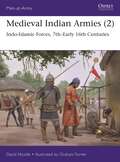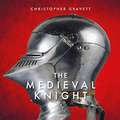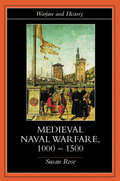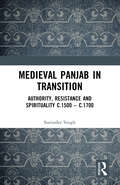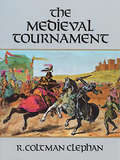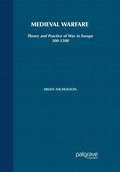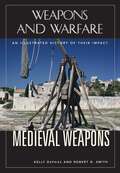- Table View
- List View
Medieval Indian Armies: Hindu, Buddhist and Jain (Men-at-Arms)
by David NicolleThis fully illustrated study explores the armies of the Hindu, Buddhist and Jain states within what are now India, Pakistan, Bangladesh, Sri Lanka and Nepal during the period AD 500–1500, as well as Afghanistan until the early 13th century AD.Following the emergence of a distinct 'medieval Indian' civilization in the Late Classical and Early Medieval periods, there was a prolonged struggle between this civilization and that of the eastern Islamic world, concluding with the rise of the Mughal Empire at the start of the 16th century. In this fully illustrated study, David Nicolle investigates the traditions and enduring conservatism of non-Islamic medieval Indian warfare, notably evident in recruitment patterns and the significance of archery and cavalry. The role and impact of war-elephants, both positive and negative, are also considered, as well as the influence of climate and weather (notably the seasonal monsoon) on warfare in this region. As well as assessing arms and armour – contrasting the advanced technology and high status of Indian weapons (especially swords) with the remarkable lack of metallic armour in the region during this period – the author also explores siege warfare and riverine and naval warfare in South Asia. This book assesses the contributing factors identified by those who have sought to explain why the huge wealth and substantial populations of the traditional non-Islamic Indian states did not prevent their persistent failure in the face of Islamic invasion and conquest.
Medieval Indian Armies: Indo-Islamic Forces, 7th–Early 16th Centuries (Men-at-Arms #552)
by Dr David NicolleThis illustrated study investigates the Indo-Islamic fighting men of South Asia from the 7th century AD to the Mughal conquest of the 16th century.From 1206, much of what is now India as well as parts of Pakistan, Bangladesh and Nepal were ruled by a succession of Islamic dynasties that had their origins in the Ghurid forces that conquered parts of northern India in the 12th century. Although it was never complete, the Islamic domination of this huge region also had a profound impact upon Islamic civilization as a whole, not least in military terms, being felt as far west as Africa. Within South Asia, the war-torn medieval centuries laid the foundations for the subsequent even more brilliant Mughal Empire.Featuring eight plates of superb artwork alongside carefully chosen photographs and illustrations, this study complements the same author's Medieval Indian Armies (1): Hindu, Buddhist and Jain. It describes and illustrates the Indo-Islamic forces operating in South Asia, from the Umayyad Caliphate's frontier in north-western India and Afghanistan in the late 7th century through to the Delhi Sultanate, the Sultanate of Bengal and the Bahmani Sultanate in the 15th and 16th centuries.David Nicolle explains how, with respect to arms, armour, fortification and transport both on land and at sea, the widely successful Muslim armies learned a great deal from their more numerous Hindu, Jain and Buddhist opponents. This was especially evident in developments such as the use of war-elephants and the adoption of lighter, often textile-based forms of protection such as 'soft armour' made of cotton. On the other side, there would be widespread adoption of more potent weapons such as the composite bow, and considerably more sophisticated systems of cavalry warfare, among the non-Islamic forces of the Indian sub-continent. Fully illustrated, this absorbing account casts light on many centuries of warfare in South Asia.
Medieval Indian Armies: Indo-Islamic Forces, 7th–Early 16th Centuries (Men-at-Arms #552)
by Dr David NicolleThis illustrated study investigates the Indo-Islamic fighting men of South Asia from the 7th century AD to the Mughal conquest of the 16th century.From 1206, much of what is now India as well as parts of Pakistan, Bangladesh and Nepal were ruled by a succession of Islamic dynasties that had their origins in the Ghurid forces that conquered parts of northern India in the 12th century. Although it was never complete, the Islamic domination of this huge region also had a profound impact upon Islamic civilization as a whole, not least in military terms, being felt as far west as Africa. Within South Asia, the war-torn medieval centuries laid the foundations for the subsequent even more brilliant Mughal Empire.Featuring eight plates of superb artwork alongside carefully chosen photographs and illustrations, this study complements the same author's Medieval Indian Armies (1): Hindu, Buddhist and Jain. It describes and illustrates the Indo-Islamic forces operating in South Asia, from the Umayyad Caliphate's frontier in north-western India and Afghanistan in the late 7th century through to the Delhi Sultanate, the Sultanate of Bengal and the Bahmani Sultanate in the 15th and 16th centuries.David Nicolle explains how, with respect to arms, armour, fortification and transport both on land and at sea, the widely successful Muslim armies learned a great deal from their more numerous Hindu, Jain and Buddhist opponents. This was especially evident in developments such as the use of war-elephants and the adoption of lighter, often textile-based forms of protection such as 'soft armour' made of cotton. On the other side, there would be widespread adoption of more potent weapons such as the composite bow, and considerably more sophisticated systems of cavalry warfare, among the non-Islamic forces of the Indian sub-continent. Fully illustrated, this absorbing account casts light on many centuries of warfare in South Asia.
The Medieval Knight: Explore The Lives Of Medieval Mounted Warriors From The Battlefield To The Banqu (The\world Of...ser.the\world Of...series)
by Christopher GravettThe 'knight in shining armour' has become a staple figure in popular culture, and images of bloody battlefields, bustling feasting halls and courtly tournaments have been creatively interpreted many times in film and fiction. But what was the medieval knight truly like? In this fascinating title, former Senior Curator at the Royal Armouries Christopher Gravett describes how knights evolved over three centuries of English and European history, the wars they fought, their lives both in peacetime and on campaign, the weapons they fought with, the armour and clothing they wore and their fascinating code and mythology of chivalry. The text is richly illustrated with images ranging from manuscript illustrations to modern artwork reconstructions and many photographs of historic artefacts and sites.
The Medieval Knight
by Christopher GravettThe 'knight in shining armour' has become a staple figure in popular culture, and images of bloody battlefields, bustling feasting halls and courtly tournaments have been creatively interpreted many times in film and fiction. But what was the medieval knight truly like? In this fascinating title, former Senior Curator at the Royal Armouries Christopher Gravett describes how knights evolved over three centuries of English and European history, the wars they fought, their lives both in peacetime and on campaign, the weapons they fought with, the armour and clothing they wore and their fascinating code and mythology of chivalry. The text is richly illustrated with images ranging from manuscript illustrations to modern artwork reconstructions and many photographs of historic artefacts and sites.
The Medieval Longsword (Weapon)
by Neil GrantThe formidable European longsword – featuring a double-edged straight blade in excess of 40in, and capable of being used with one or both hands – remains one of the most impressive and distinctive edged weapons of the late medieval era. Also known as the 'bastard' sword and the 'hand-and-a-half' sword, the longsword evolved from the war swords and great swords of the 14th century, and emerged as a battlefield weapon in the early stages of the Hundred Years' War. It went on to become a key weapon on the battlefields of late medieval Europe, creating a new system of sword fighting. Drawing together period sources, modern technical analysis and his own experiences with the longsword, Neil Grant explores the origins, manufacture and evolving use of this iconic late-medieval edged weapon. Illustrated throughout with specially commissioned full-colour artwork and an array of period illustrations and close-up photographs, this is the enthralling story of one of late-medieval Europe's most distinctive and deadly close-combat weapons.
The Medieval Longsword (Weapon #48)
by Neil GrantThe formidable European longsword – featuring a double-edged straight blade in excess of 40in, and capable of being used with one or both hands – remains one of the most impressive and distinctive edged weapons of the late medieval era. Also known as the 'bastard' sword and the 'hand-and-a-half' sword, the longsword evolved from the war swords and great swords of the 14th century, and emerged as a battlefield weapon in the early stages of the Hundred Years' War. It went on to become a key weapon on the battlefields of late medieval Europe, creating a new system of sword fighting. Drawing together period sources, modern technical analysis and his own experiences with the longsword, Neil Grant explores the origins, manufacture and evolving use of this iconic late-medieval edged weapon. Illustrated throughout with specially commissioned full-colour artwork and an array of period illustrations and close-up photographs, this is the enthralling story of one of late-medieval Europe's most distinctive and deadly close-combat weapons.
Medieval Naval Warfare 1000-1500
by Susan RoseHow were medieval navies organised, and how did powerful rulers use them? Medieval Naval Warfare, 1000-1500 provides a wealth of information about the strategy and tactics of these early fleets and the extent to which the possibilities of sea power were understood and exploited. This fascinating account brings vividly to life the dangers and diffic
Medieval Naval Warfare 1000-1500 (Warfare And History Ser.)
by Susan RoseHow were medieval navies organised, and how did powerful rulers use them? Medieval Naval Warfare, 1000-1500 provides a wealth of information about the strategy and tactics of these early fleets and the extent to which the possibilities of sea power were understood and exploited. This fascinating account brings vividly to life the dangers and diffic
Medieval Panjab in Transition: Authority, Resistance and Spirituality c.1500 – c.1700
by Surinder SinghThis book reconstructs the historical transition in the undivided Panjab during the sixteenth and seventeenth centuries. It shows that the assertion of Mughal and Afghan suzerainty faced sustained resistance from local elements, particularly the autonomous tribes and hill chiefdoms. In central plains, Dulla Bhatti mobilized the toilers of his ancestral domain and, leading a relentless fight against the Mughal oppression, became an abiding symbol of resistance in the collective memory. The multicultural legacy of Panjab evolved through diverse strands of spirituality. The jogis, wedded to monastic discipline, supernatural abilities and land grants, gained acceptance through their exertions for social betterment. The Sabiri and Qadiri silsilas channelized mystical urges towards the technique of prime recitation. The popular verses of Shah Husain, Baba Lal and Sultan Bahu proposed a loving relation with God. The legendary lovers, perishing in the struggles against patriarchal forces, promoted a merger of dissent with spirituality. In the city of Lahore, the material pursuits and cultural life were visible in a mosaic of descriptions, including episodes of social tension. The book understands the upliftment of depressed castes as a defining feature of Sikhism. It places egalitarian concern of the Sikh Gurus alongside the anti-caste protests of Namdev, Kabir and Ravidas. Owing to scriptural authority and congregational equality, the members of depressed castes attained a numerical majority in the Sikh warrior bands that shook the foundations of the Mughal state. The work relies on evidence from the Persian chronicles, Mughal newsletters, Sufi writings, Sikh literature and Punjabi folklore. Please note: Taylor & Francis does not sell or distribute the Hardback in India, Pakistan, Nepal, Bhutan, Bangladesh and Sri Lanka.
Medieval Panjab in Transition: Authority, Resistance and Spirituality c.1500 – c.1700
by Surinder SinghThis book reconstructs the historical transition in the undivided Panjab during the sixteenth and seventeenth centuries. It shows that the assertion of Mughal and Afghan suzerainty faced sustained resistance from local elements, particularly the autonomous tribes and hill chiefdoms. In central plains, Dulla Bhatti mobilized the toilers of his ancestral domain and, leading a relentless fight against the Mughal oppression, became an abiding symbol of resistance in the collective memory. The multicultural legacy of Panjab evolved through diverse strands of spirituality. The jogis, wedded to monastic discipline, supernatural abilities and land grants, gained acceptance through their exertions for social betterment. The Sabiri and Qadiri silsilas channelized mystical urges towards the technique of prime recitation. The popular verses of Shah Husain, Baba Lal and Sultan Bahu proposed a loving relation with God. The legendary lovers, perishing in the struggles against patriarchal forces, promoted a merger of dissent with spirituality. In the city of Lahore, the material pursuits and cultural life were visible in a mosaic of descriptions, including episodes of social tension. The book understands the upliftment of depressed castes as a defining feature of Sikhism. It places egalitarian concern of the Sikh Gurus alongside the anti-caste protests of Namdev, Kabir and Ravidas. Owing to scriptural authority and congregational equality, the members of depressed castes attained a numerical majority in the Sikh warrior bands that shook the foundations of the Mughal state. The work relies on evidence from the Persian chronicles, Mughal newsletters, Sufi writings, Sikh literature and Punjabi folklore. Please note: Taylor & Francis does not sell or distribute the Hardback in India, Pakistan, Nepal, Bhutan, Bangladesh and Sri Lanka.
Medieval Russian Fortresses AD 862–1480 (Fortress)
by Peter Dennis Konstantin S NossovAccording to Russian legend, in the year AD 862 the Slav tribes of what is now European Russia invited a number of Scandinavian princes to rule over them. However, on the death of these princes, Prince Oleg seized Kiev and united the Northern and Southern Russian territories, building extensive fortifications to protect its borders. The rise of feudalism in the 11th century lead to the development of individual fortified sites and the extended border defenses fell into disrepair. Consequently, Mongol hordes poured over the border introducing the siege warfare techniques of the East, heavily influencing the fortification styles thereafter. Using a wealth of archeological evidence and first-hand sources, Konstantin Nossov charts the history of the medieval Russian fortress from its early beginnings until the 14th century, paying special attention to the development of one of the most iconic fortifications in the world: the Kremlin.
Medieval Russian Fortresses AD 862–1480 (Fortress #Vol. 61)
by Peter Dennis Konstantin S NossovAccording to Russian legend, in the year AD 862 the Slav tribes of what is now European Russia invited a number of Scandinavian princes to rule over them. However, on the death of these princes, Prince Oleg seized Kiev and united the Northern and Southern Russian territories, building extensive fortifications to protect its borders. The rise of feudalism in the 11th century lead to the development of individual fortified sites and the extended border defenses fell into disrepair. Consequently, Mongol hordes poured over the border introducing the siege warfare techniques of the East, heavily influencing the fortification styles thereafter. Using a wealth of archeological evidence and first-hand sources, Konstantin Nossov charts the history of the medieval Russian fortress from its early beginnings until the 14th century, paying special attention to the development of one of the most iconic fortifications in the world: the Kremlin.
The Medieval Soldier in the Wars of the Roses: Men Who Fought the Wars of the Roses
by Andrew Boardman‘An essential part of the library for anyone interested in the great political and military upheavals in the 15th century.’ – Graeme Rimer, Retired Former Academic Director of the Royal Armouries‘A creditable effort to examine a neglected aspect of medieval warfare.’ – Jim Bradbury, Cambridge University Press ‘Everything you need to know about being a soldier in the Wars of the Roses.’ – The Mail BookshopWhat was it like to fight in a Wars of the Roses battle? What kind of men fought at St Albans, Northampton, Wakefield, Towton, Tewkesbury and Bosworth? How was the medieval soldier recruited, paid, equipped, fed and billeted? And how was a battle contested once both sides resorted to all-out conflict?First published in 1998, this classic study of the medieval soldier in the Wars of the Roses examines these and other questions using various documentary sources and recent evidence. Eyewitness accounts, contemporary chronicles, personal letters, civic records, archaeology and surviving military equipment are used to paint a fascinating picture of the medieval soldier. Evidence gleaned from the mass war grave found close to the battlefield of Towton in North Yorkshire sheds new light on those that lived and died in the civil wars. But what do we know about the psychology of those involved? And how did soldiers feel about killing their fellow Englishmen?Andrew Boardman explores the grim reality of medieval soldiering on land and sea during this crucial period of aristocratic violence and dynastic upheaval. He makes us question the current historical record, such as it is, and our perceptions of chivalry and warfare in Lancastrian and Yorkist England. The text is supported by many contemporary illustrations, diagrams and maps, making this updated work an indispensable guide to medieval soldiering in the late fifteenth century.
The Medieval Tournament
by R. Coltman ClephanComplete, detailed history of English and European tournaments, based on rare manuscripts and original sources. Topics include Arthurian and other round tables, body armor, chain mail, plate armor, royal jousts, introduction of firearms in the 14th century, the tilt, effigies, trial by combat, duels and many other aspects. 24 illustrations. Bibliography. Index.
Medieval Warfare: Theory And Practice Of War In Europe, 300-1500
by Helen NicholsonWarfare in medieval times was never static or predictable - although there were ideals and conventions to follow, in the field commanders had to use their initiative and adapt to the needs of the moment. In this concise, wide-ranging study, Helen Nicholson provides the essential introductory guide to a fascinating subject. Medieval Warfare - surveys and summarises current debates and modern research into warfare throughout the whole of the medieval period across Europe - sets medieval warfare theory and practice firmly into context as a continuation and adaptation of practice under the Roman Empire, tracing its change and development across more than a millennium - considers military personnel, buildings and equipment, as well as the practice of warfare by land and sea
Medieval Warfare: Theory and Practice of War in Europe, 300-1500
by Helen J. NicholsonWarfare in medieval times was never static or predictable - although there were ideals and conventions to follow, in the field commanders had to use their initiative and adapt to the needs of the moment. In this concise, wide-ranging study, Helen Nicholson provides the essential introductory guide to a fascinating subject.Medieval Warfare- surveys and summarises current debates and modern research into warfare throughout the whole of the medieval period across Europe- sets medieval warfare theory and practice firmly into context as a continuation and adaptation of practice under the Roman Empire, tracing its change and development across more than a millennium- considers military personnel, buildings and equipment, as well as the practice of warfare by land and sea
Medieval Warfare: Theory and Practice of War in Europe, 300-1500
by Helen J. NicholsonWarfare in medieval times was never static or predictable - although there were ideals and conventions to follow, in the field commanders had to use their initiative and adapt to the needs of the moment. In this concise, wide-ranging study, Helen Nicholson provides the essential introductory guide to a fascinating subject.Medieval Warfare- Surveys and summarises current debates and modern research into warfare throughout the whole of the medieval period across Europe- Sets medieval warfare theory and practice firmly into context as a continuation and adaptation of practice under the Roman Empire, tracing its change and development across more than a millennium- Considers military personnel, buildings and equipment, as well as the practice of warfare by land and sea
Medieval Warfare 1300–1450 (The International Library of Essays on Military History)
by Kelly DeVriesWar was epidemic in the late Middle Ages. It affected every land and all peoples from Scotland and Scandinavia in the north to the southern Mediterranean Sea coastlines of Morocco, North Africa, Egypt, and the Middle East in the south, from Ireland and Spain in the west to Russia and Turkey in the east. Nowhere was peaceful for any significant amount of time. The period also saw significant changes in military theory and practice which altered the ways in which campaigns were conducted, battles fought, and sieges laid; and changes in the leadership, recruitment, training, supply and financing of armies. There were changes in the relationship between those waging warfare, from generals to irregular troops, and the society in which they lived and for or against which they fought; the frequency of popular rebellions and the participation in them by townspeople and peasants; changes in the desire to undertake Crusades, and changes in technology, including but not limited to gunpowder weapons. This collection gathers together some of the best published work on these topics. The first section of seven papers show that throughout Europe in the later Middle Ages generals led and armies followed what are usually defined as "modern" strategy and tactics, contrary to popular belief. The second part reprints nine works that examine the often neglected aspects of the process of putting and keeping together a late medieval army. In the third section the authors discuss various ways that warfare in the fourteenth and fifteenth century affected the society of that period. The final sections cover popular rebellions and crusading.
Medieval Warfare 1300–1450 (The International Library of Essays on Military History)
by Kelly DeVriesWar was epidemic in the late Middle Ages. It affected every land and all peoples from Scotland and Scandinavia in the north to the southern Mediterranean Sea coastlines of Morocco, North Africa, Egypt, and the Middle East in the south, from Ireland and Spain in the west to Russia and Turkey in the east. Nowhere was peaceful for any significant amount of time. The period also saw significant changes in military theory and practice which altered the ways in which campaigns were conducted, battles fought, and sieges laid; and changes in the leadership, recruitment, training, supply and financing of armies. There were changes in the relationship between those waging warfare, from generals to irregular troops, and the society in which they lived and for or against which they fought; the frequency of popular rebellions and the participation in them by townspeople and peasants; changes in the desire to undertake Crusades, and changes in technology, including but not limited to gunpowder weapons. This collection gathers together some of the best published work on these topics. The first section of seven papers show that throughout Europe in the later Middle Ages generals led and armies followed what are usually defined as "modern" strategy and tactics, contrary to popular belief. The second part reprints nine works that examine the often neglected aspects of the process of putting and keeping together a late medieval army. In the third section the authors discuss various ways that warfare in the fourteenth and fifteenth century affected the society of that period. The final sections cover popular rebellions and crusading.
Medieval Warfare: Technology, Military Revolutions, and Strategy (Variorum Collected Studies)
by Clifford J. RogersThis volume explores the topics of military revolutions, strategy, and tactics both separately and as they relate to each other. It makes important contributions to understanding European warfare in the Early, High, and especially the Late Middle Ages, as well the military transition to the Early Modern Period.Readers will find detailed analysis of how technological and non-technological developments interacted to effect major changes in how wars were fought across the period. The evolution and capabilities of the English longbow and of early gunpowder artillery are examined in depth. Changes in the tools of war naturally affected plans to employ those tools to achieve political ends – military strategy – but strategy was never dictated by technology. That point is illustrated by examinations of English efforts to conquer Wales; the Anglo-Burgundian alliance of the late Hundred Years War; and the economic factors shaping medieval conquests in general.The nine studies in the volume have all been published previously, but a new introduction shows how they fit together, particularly explaining how they collectively rebut common critiques of Rogers’s controversial thesis that European warfare was reshaped by the Infantry and Artillery Revolutions during the era of the Hundred Years War. Two of the chapters have been substantially expanded, so that the versions printed here should be the ones consulted and cited in the future by scholars of medieval warfare and military revolutions.
Medieval Warfare: Technology, Military Revolutions, and Strategy (Variorum Collected Studies)
by Clifford J. RogersThis volume explores the topics of military revolutions, strategy, and tactics both separately and as they relate to each other. It makes important contributions to understanding European warfare in the Early, High, and especially the Late Middle Ages, as well the military transition to the Early Modern Period.Readers will find detailed analysis of how technological and non-technological developments interacted to effect major changes in how wars were fought across the period. The evolution and capabilities of the English longbow and of early gunpowder artillery are examined in depth. Changes in the tools of war naturally affected plans to employ those tools to achieve political ends – military strategy – but strategy was never dictated by technology. That point is illustrated by examinations of English efforts to conquer Wales; the Anglo-Burgundian alliance of the late Hundred Years War; and the economic factors shaping medieval conquests in general.The nine studies in the volume have all been published previously, but a new introduction shows how they fit together, particularly explaining how they collectively rebut common critiques of Rogers’s controversial thesis that European warfare was reshaped by the Infantry and Artillery Revolutions during the era of the Hundred Years War. Two of the chapters have been substantially expanded, so that the versions printed here should be the ones consulted and cited in the future by scholars of medieval warfare and military revolutions.
The Medieval Way of War: Studies in Medieval Military History in Honor of Bernard S. Bachrach
by Gregory I. HalfondFew historians have argued so forcefully or persuasively as Bernard S. Bachrach for the study of warfare as not only worthy of scholarly attention, but demanding of it. In his many publications Bachrach has established unequivocally the relevance of military institutions and activity for an understanding of medieval European societies, polities, and mentalities. In so doing, as much as any scholar of his generation, he has helped to define the status quaestionis for the field of medieval military history. The Medieval Way of War: Studies in Medieval Military History in Honor of Bernard S. Bachrach pays tribute to its honoree by gathering in a single volume seventeen original studies from an international roster of leading experts in the military history of medieval Europe. Ranging chronologically from Late Antiquity through the Later Middle Ages (ca. AD 300-1500), and with a broad geographical scope stretching from the British Isles to the Middle East, these diverse studies address an array of critical themes and debates relevant to the conduct of war in medieval Europe. These themes include the formation and implementation of military grand strategies; the fiscal, material, and administrative resources that underpinned the conduct of war in medieval Europe; and religious, legal, and artistic responses to military violence. Collectively, these seventeen studies embrace the interdisciplinarity and topical diversity intrinsic to Bachrach’s research. Additionally, they strongly echo his conviction that the study of armed conflict is indispensable for an accurate and comprehensive understanding of medieval European history.
The Medieval Way of War: Studies in Medieval Military History in Honor of Bernard S. Bachrach
by Gregory I. HalfondFew historians have argued so forcefully or persuasively as Bernard S. Bachrach for the study of warfare as not only worthy of scholarly attention, but demanding of it. In his many publications Bachrach has established unequivocally the relevance of military institutions and activity for an understanding of medieval European societies, polities, and mentalities. In so doing, as much as any scholar of his generation, he has helped to define the status quaestionis for the field of medieval military history. The Medieval Way of War: Studies in Medieval Military History in Honor of Bernard S. Bachrach pays tribute to its honoree by gathering in a single volume seventeen original studies from an international roster of leading experts in the military history of medieval Europe. Ranging chronologically from Late Antiquity through the Later Middle Ages (ca. AD 300-1500), and with a broad geographical scope stretching from the British Isles to the Middle East, these diverse studies address an array of critical themes and debates relevant to the conduct of war in medieval Europe. These themes include the formation and implementation of military grand strategies; the fiscal, material, and administrative resources that underpinned the conduct of war in medieval Europe; and religious, legal, and artistic responses to military violence. Collectively, these seventeen studies embrace the interdisciplinarity and topical diversity intrinsic to Bachrach’s research. Additionally, they strongly echo his conviction that the study of armed conflict is indispensable for an accurate and comprehensive understanding of medieval European history.
Medieval Weapons: An Illustrated History of Their Impact (Weapons and Warfare)
by Robert D. Smith Kelly DeVriesThis fascinating reference covers the weapons and armor used by warriors from the 4th to the 15th century and discusses how and why they changed over time.In the Middle Ages, the lack of standardized weapons meant that one warrior's arms were often quite different from another's, even when they were fighting on the same side. And with few major technological advances in that period, the evolution of those weapons over the centuries was incremental. But evolve they ultimately did, bringing arms, armor, and siege weapons to the threshold of the modern era. From the fall of the Roman Empire to the beginnings of the Renaissance, Medieval Weapons: An Illustrated History of Their Impact covers the inexorable transformation from warrior in the mail shirt to fully armored knight, from the days of spears and swords to the large-scale adoption of the handgun.Medieval Weapons covers this fascinating expanse of centuries in chapters devoted to the early medieval, Carolingian, Crusade, and late medieval periods. Within each period, the book details how weapons and armor were developed, what weapons were used for different types of battles, and how weapons and armor both influenced, and were influenced by, changing tactics in battles and sieges.

